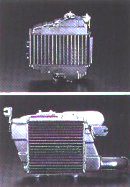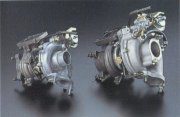|
|
TURBO/IC |
|
The turbocharger was specifically developed for the
GT-R application by IHI.
|
![]() |
![]() |
|
The
turbocharger was specifically developed for the GT-R application by
IHI. The RHF6CB turbocharger has a 62.0-mm diameter turbine and a
large 65.0-mm compressor. By comparison the turbo for the type BPD
1.8 liter engine that powers the GTX has a 52.5-mm diameter turbine
and a 52.5-mm compressor. It is commonly believed that a big turbo
is employed for high rpm power. The Mazda and IHI teams have proven
with the GT-R turbo installation that this is not necessarily so.
They have sought and achieved an optimum balance between high power
and quick mid-to-high rpm response. A relatively small "A/R" ration,
a value of 16 to the GTX's 15, was one of the means they adopted to
assure these desirable characteristics. "A" is the smallest scroll
area and "R" the distance between the turbine-shaft center and the
center of area "A", the two factors used in calculating
turbocharger's performance characteristics. The turbocharger
employ's a steel turbine wheel for its proven reliability under the
rigors of competition. In Mazda's testing it suffered little in
responsiveness when compared with a unit fitted with an experimental
ceramic turbine; the latter may be decelerating too quickly for any
appreciable difference in pickup that follows. The turbocharger
shaft is supported by ball bearing, which improves turbo response by
as much as 7% by Mazda's testing.
The turbocharger is
watercooled. Boost is controlled by a dedicated computer map, and
its maximum pressure is 450 mm of mercury (Hg). The standard
air-to-air intercooler is about twice the size of the unit fitted in
the GTX (235-mm wide, 225-mm high and 65-mm deep), and has a heat
dissipating capacity of 6,150 Kcal/hour which is 36% more than the
GTX's. It features efficient "zig-zag" fins which increase cooling
surface area. The intercooler is located in the nose of the car,
immediately ahead the coolant radiator. the path the boosted air
takes to the engine's intake system is as direct and short as
possible, so that pressure loss is minimized.


|
|
|
|
|
|
Manifold System:
With the "Big Turbo", it has become
critical that boosted air is distributed to the individual cylinders
in equal volume and pressure. Likewise, the energy of exhaust gas
must be fully exploited to quickly "spin-up" the big turbine in
order to obtain high power and minimum turbo lag.
The Mazda
engine design team has perfected a unique manifold system, combining
the air volume and pressure equalizing intake and exhaust extractor
manifolds.
It was Mazda's finding that with more a more commonly
used equal-length intake manifold, the tract nearest to the air
entry received the least volume/pressure, and the farthest tract the
most. By trial, measurement and testing, the engine team perfected a
cast aluminum manifold that has intricately curved and sized "walls"
between the individual tracts leading to the intake ports to
equalize air volume and pressure. A bonus is that the manifold's
swirl generating effect contribute to efficient combustion. The
equalizer intake manifolds have shown its effectiveness in improving
torque from idling to the Group-A 300-bhp-plus output level and all
the way up to maximum revs.
The exhaust manifold has individual
tracts collecting at the turbocharger entry. These tracts are in two
groups; the tracts from cylinders 1 and 4 are routed to the center,
and those from cylinders 2 and 3 to the outside. This routing allows
nearly equal tract length. The complex manifold is made of cast
ferrite steel, for which the lost-form casting method is employed.
Not only is this about 20 percent lighter, much stronger and its
passages much smoother than a conventional cast iron one, but also
its surface finish is much smoother.
The exhaust manifold's
extracting ability precludes an unwanted rise in exhaust
back-pressure, which would cause the dilution of the combustion
chambers with exhaust gas. This would, in turn, raise cylinder
temperatures. Enriching the fuel/air mixture to lower combustion
temperatures would obviously deteriorate fuel economy.
The GT-R
exhaust system adopts a 3-way catalytic converter with larger
capacity but a reduced number of cells, and a new main silencer that
assures reduced resistance to gas flow.
| |